
En cliquant sur Continuer, je certifie avoir plus de 18 ans.

En cliquant sur Continuer, je certifie avoir plus de 18 ans.
Armagnac is the oldest brandy produced in South-West France, in the heart of Gascony. It is made by distilling white wine in a single-distillation still, known as the Armagnac still, followed by lengthy ageing in oak casks.
Armagnac is first and foremost a craft spirit, made in small quantities by wine growers or shipping companies that boast long-standing expertise. Its colourful, multi-faceted personality with a close bond to nature and the people who make it, stems from the broad array of terroirs and grape varieties from which Armagnac is made.
It is the sum of natural components that characterise a given wine area, i.e. soil types, aspect and the resultant microclimate. Terroir is one of three factors that play a part in a wine’s quality and character; the two others are grape varieties and human input (wine making and ageing procedures).
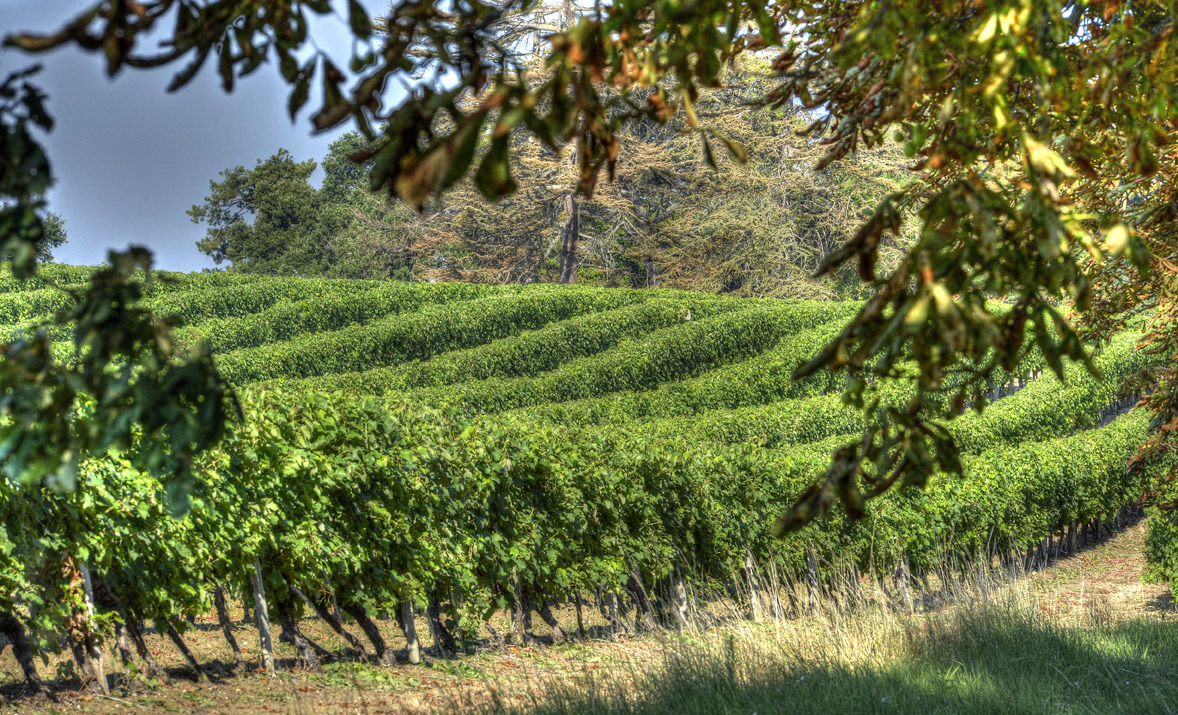
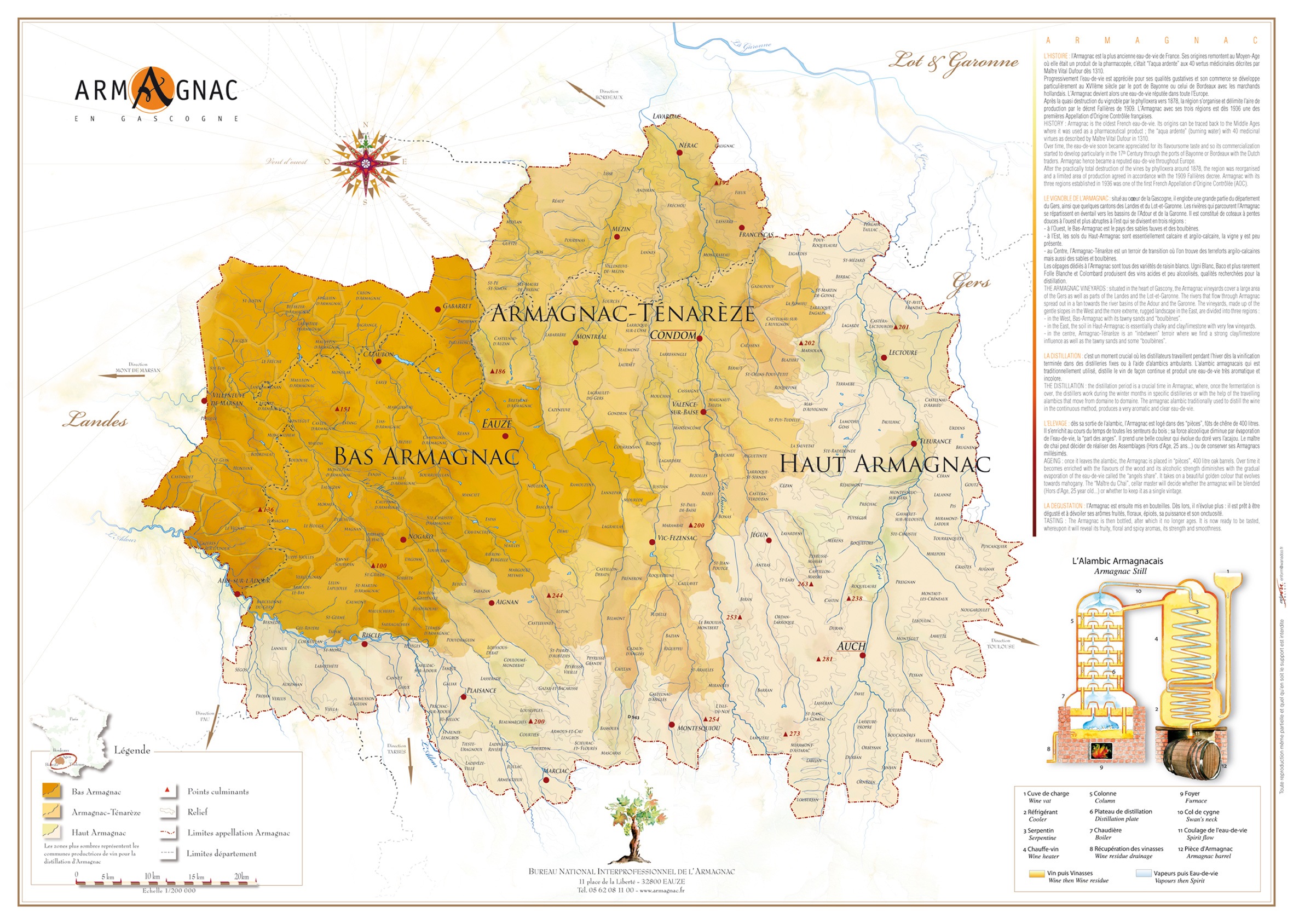
The Armagnac region extends over an extensive area in the Gers department, the eastern part of the Landes and the southern tip of Lot-et-Garonne. The appellation area is unusual in that it is shaped like a vine leaf. It is divided into three sub-appellations: Bas-Armagnac, Ténarèze and Haut-Armagnac.
« Great diversity »
The entire area located between the Pyrenees and the Massif Central is the site of an ancient gulf that remained submerged for aeons. The waters only receded relatively recently, at the end of the Tertiary period, leaving behind them a thick layer of silt, now clayey molasses interspersed by limestone ridges (Abel Sempé, ‘La Grande Messe de l’Armagnac’). The subsoils along the Armagnac plateau are therefore composed of Pyrenean debris, swept along by the sea.
In western Gers and part of the Landes, the sea left behind a soil formation from the Miocene period known as ‘fawn sands’ which are formed of fine quartz sands and whose colour is derived from small amounts of iron hydroxide. Younger silt soils known as ‘boulbenes’ are also found. The centre of the appellation is home to the Ténarèze area (‘the crest trail’), the appellation’s backbone dividing Bas-Armagnac and Haut-Armagnac which forms the watershed between the Garonne on one side and the Adour on the other. This is a transitional area where ‘boulbenes’ are joined by soils sometimes eroded down to the limestone bedrock; ‘peyrusquets’ or shallow layers of clay soil; some heavy clay-limestone known locally as ‘terrefort’; and fawn sands on the slopes. Haut-Armagnac is the area with the highest limestone content due to a majority proportion of clay-limestone ‘terreforts’.
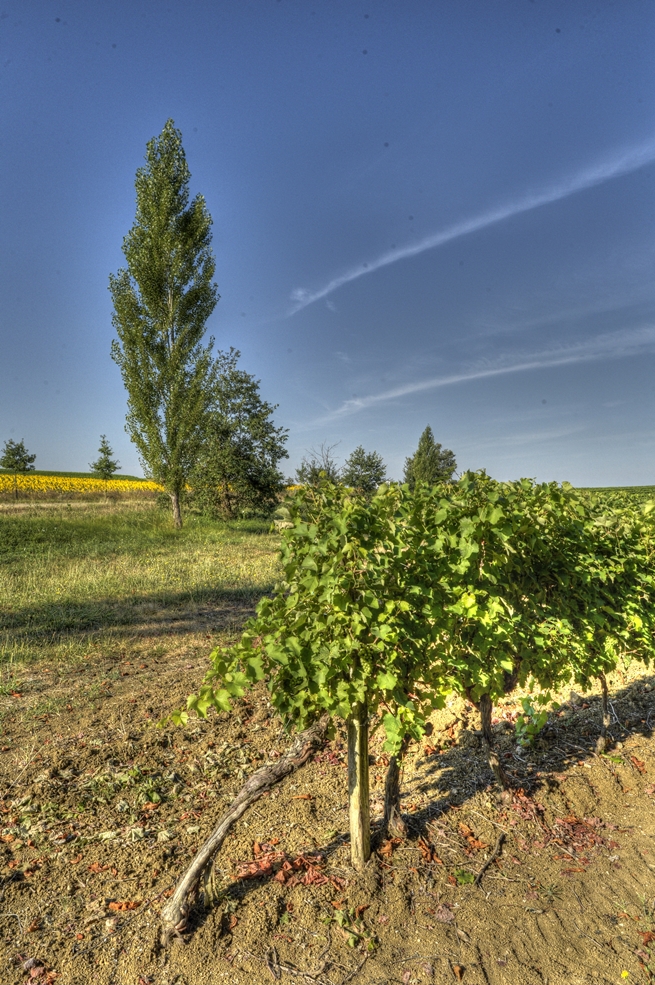
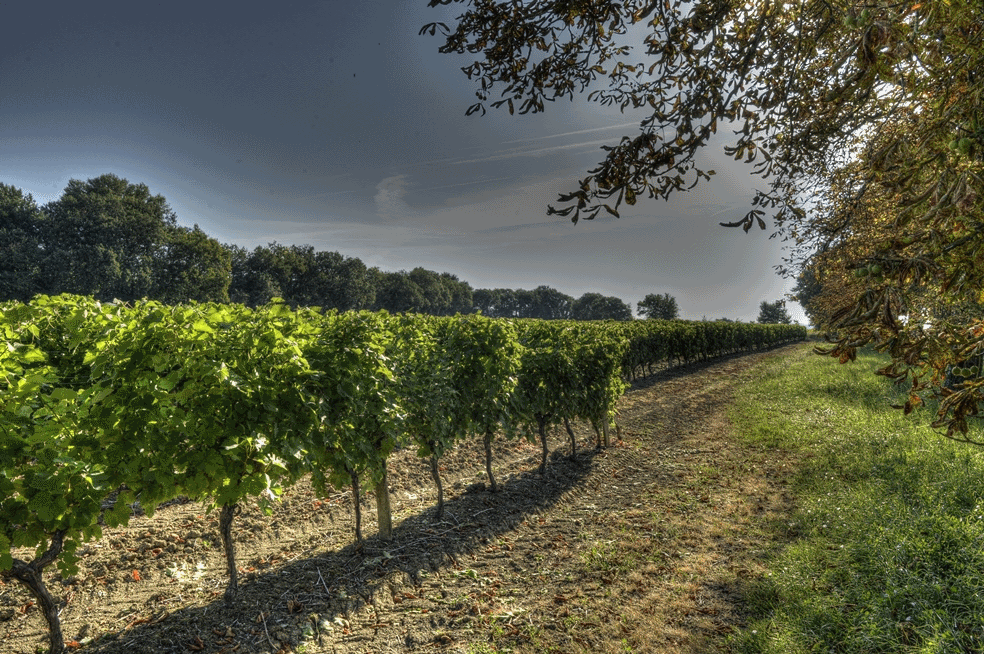
The greatest climatic influence comes from the Atlantic Ocean, particularly in the western part of the appellation, in Bas-Armagnac. The woodlands of the Landes act as a shield against rainfall and a thermal buffer: adverse weather conditions always come from the sea. In fact, all of the houses turn their backs on bad weather and face East. In the more easterly parts of the appellation, the prevailing climatic influence comes from Toulouse: the winds are easterly and south-easterly (the tail end of the Autan wind) which pushes temperatures up and has a drying effect on the soils.
Microclimates have a mitigating effect on these generalisations, depending on whether vineyards are located on hillsides or on the valley floor.
Finding the right soils for the different grape varieties has always been dictated by generations of observant wine growers who, over time, have planted cultivars in the most appropriate locations. This is perhaps slightly less true today due to the dual use of the vineyards: they produce both distilling and table wines. Ultimately, grape varieties that produce relatively bland, acidic wines with low alcohol content yield the good brandies.
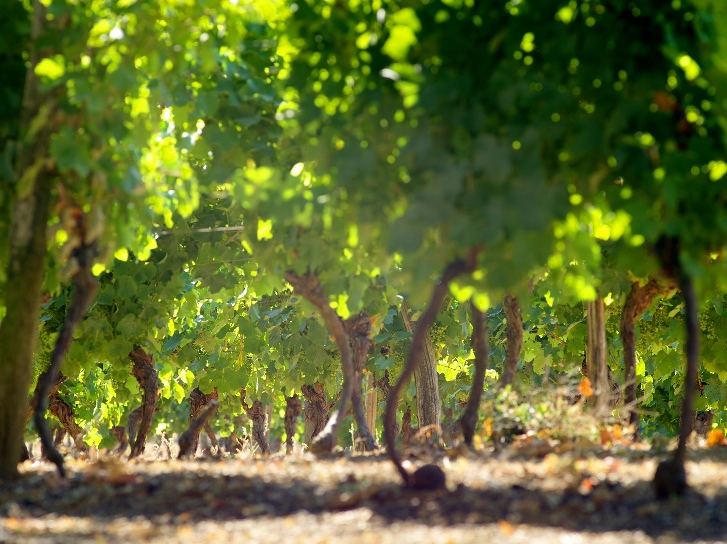
Conversely, grape varieties that are too aromatic produce brandies that are “too scented to be honest”. A decree dated August 6th 1936 stipulates use of the following cultivars: Folle blanche and Folle jaune; Piquepoult du pays; Ugni blanc; Colombard; Jurançon; Blanquette; Mauzac; Clairette; Meslier Saint-François; Plant de Grèce; and Baco 22A. The appellation area is currently home to four main grape varieties: Ugni blanc, Colombard, Folle blanche and Baco 22A. The first three are plants grafted onto phylloxera-tolerant rootstocks whereas Baco 22A is a hybrid grape variety produced by crossing the American vine Noah with Folle blanche, a traditional variety of South-Western France. It is the only hybrid still permitted in Europe. Baco 22A thrives on fawn sands, particularly those of Bas-Armagnac. It produces fat, full brandies that are suitable for ageing. Baco is also highly resistant to the leading vine diseases, except for flavescence doree. Folle blanche also fully reveals itself on sandy soils. Its acidic, low alcohol wines yield highly aromatic, refined brandies. As they age, their upfront fruit aromas fade after fifteen years or so.Ugni blanc produces brandies referred to as simple which are primarily used as a base for blending. However, some wine growers ferment and distil Ugni blanc separately and manage to achieve some highly surprising results sometimes. Colombard is rarely distilled because it yields highly drinkable, aromatic wines. Armagnacs made from Colombard are few and far between and are always used in blends.
Techniques are adjusted to suit individual requirements, cultivars, soils and climate. Their primary objective is to produce ripe, healthy grapes by using viticultural techniques that have been properly mastered and by rational use of treatments against the various vineyard parasites and diseases.
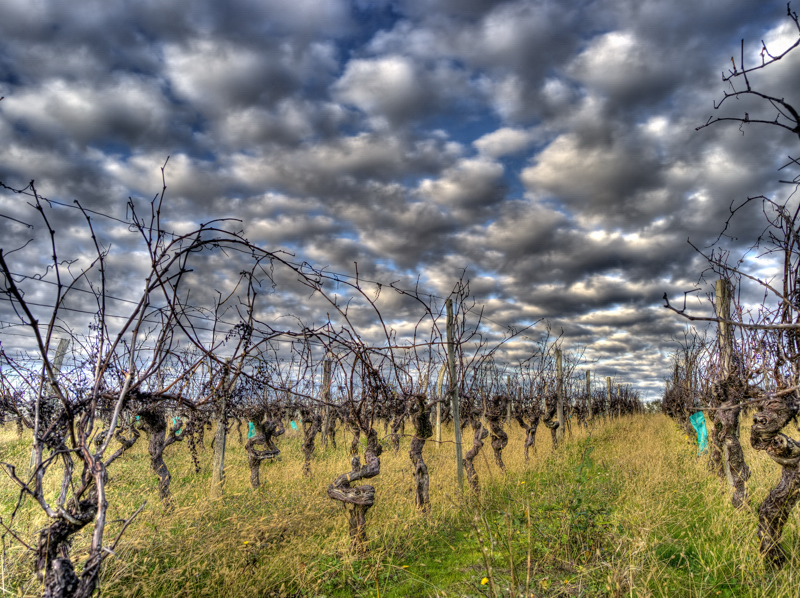
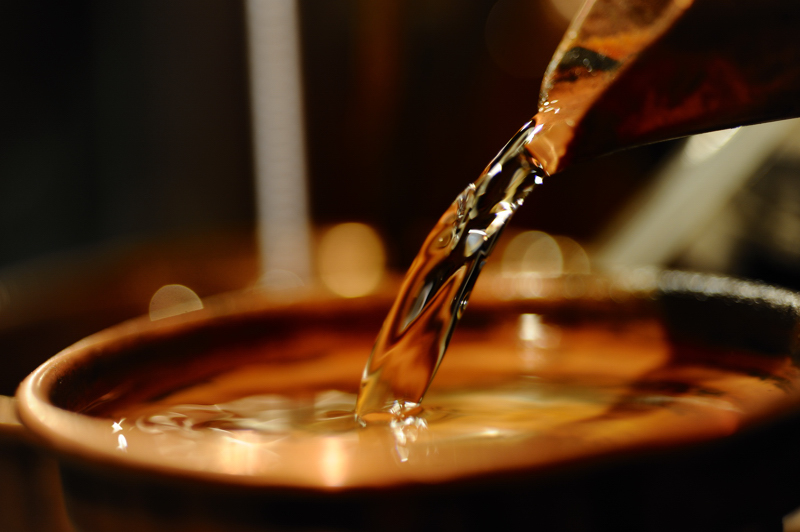
No wine making products, including sulphur, are added. The base wines have fairly low alcohol content – between 8 and 10% ABV – and high overall acidity which is the sole preservative until they are distilled. After racking and before distilling, the wines are kept on fine lees.
The wines are traditionally distilled in Armagnac stills, which were sanctified by an 1818 patent by King Louis 18th, and therefore undergo continuous distillation. This relatively gentle method allows more of the grape components to be retained (due to lower alcohol content produced by the distillation process), thereby imparting more idiosyncratic flavours. When the brandy exits the still it is colourless and has an alcohol content of between 52 and 60% vol. (the maximum legal limit is 72% vol.).
How the still works :
Wine is constantly fed into the still through the bottom of the cooler where the alcohol vapours contained in the serpentine are cooled. It is taken towards the distillation column where it drops plate by plate to the boiler. The heat created by the furnace causes the vapours from the wine to pass back up the column and bubble in the wine on each plate where they become enriched with the alcohol and aromatic substances in the wine before being condensed then cooled in the serpentine.
When the brandy exits the still it is colourless. The Armagnac is still very fiery but already reveals a broad aromatic spectrum: it is highly fruity with plummy and raisin aromas and often floral, scented with vine flowers or linden.
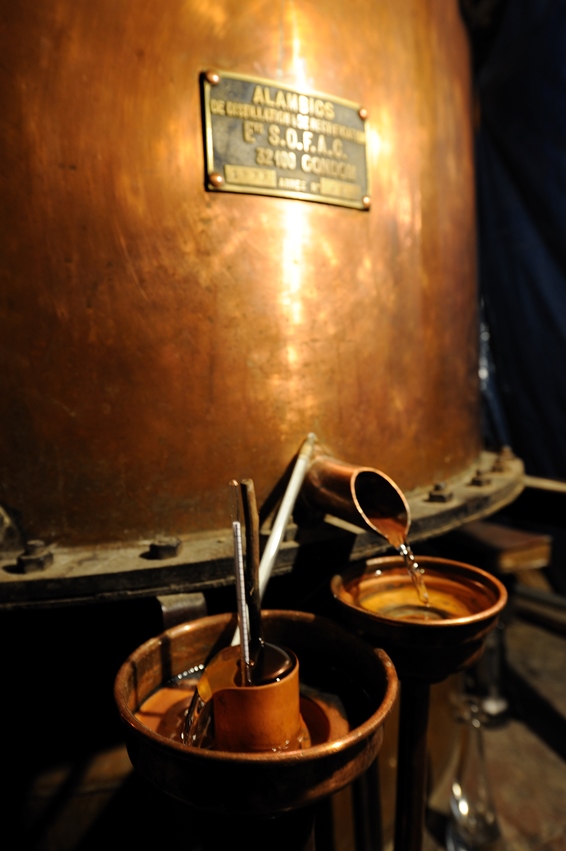
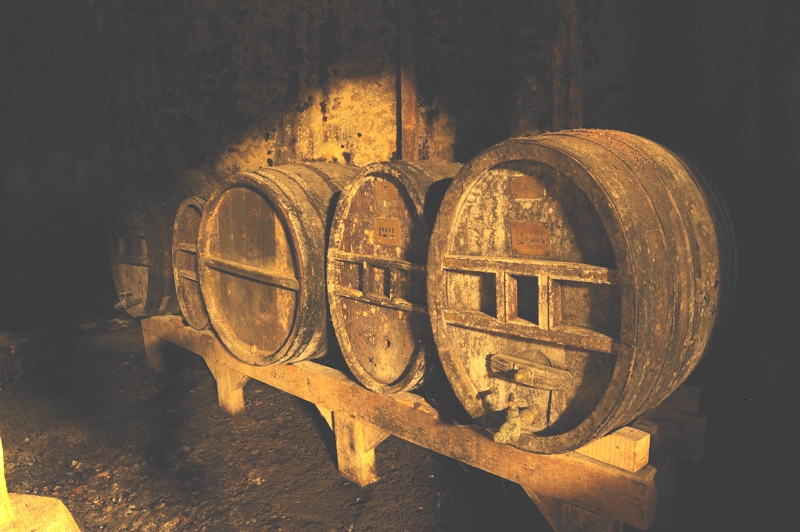
Ageing in oak allows the brandies to mature and become enhanced through a series of complex reactions during which the tannins and aromas from the wood are dissolved in the spirit. The young brandies stay in new 400-litre casks until the oak compounds have fully dissolved. They are then transferred to older, used casks to complete the transformation process. Throughout maturation, alcohol strength gradually decreases through the evaporation of alcohol, known as the ‘angel’s share’. As water evaporates, the volume also declines, promoting concentration in the resultant brandy.
The casks are stored in cellars where both temperature and humidity levels are pivotal to the quality of ageing. The oaked substances mature, aromas of vanilla and prune develop, ‘rancio’ character appears and alcohol strength gradually declines through the evaporation of alcohol (this is known as the ‘angel’s share’). The brandy dons a beautiful amber hue turning to mahogany.
When the maturation process is deemed to be complete, the ‘cuts’ or harmonious blending of several brandies of varying origins and ages begins. A brandy’s ultimate ABV (at least 40% vol) can be attained by gradually adding ‘small brandies’ or ‘petites eaux’ produced by combining distilled water and Armagnac.
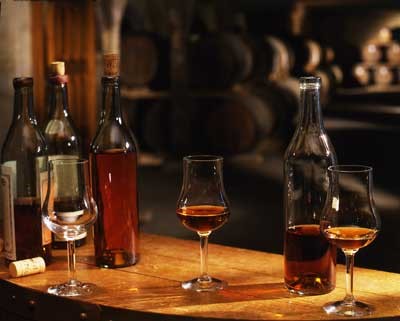
.jpg)
A vintage always relates to the year of harvest.
Reduction is not always used because when the ageing cellar is damp, the brandies are marketed at their natural alcoholic strength, usually ranging from 40% to 48% vol.
Hence, the resultant Armagnac offers up its intrinsic originality and authenticity. People who like Armagnac favour this style of brandy.